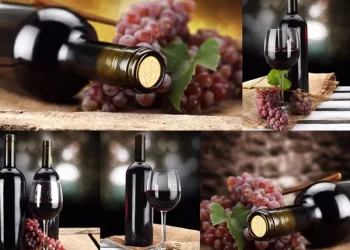As anyone who has ever drunk red wine may know, it can be quite embarrassing to finish a glass of red wine and find your teeth stained.
Here are some tips to avoid staining your teeth.
Compared to white grapes, red grape skins contain a lot of anthocyanins, which are water-soluble natural pigments.
During winemaking, anthocyanins from red grape skins are extracted into the liquor along with tannins and flavor compounds, giving the wine its attractive purplish-red color.
Our teeth have a hard protective layer called enamel, which is not completely smooth, but bumpy and has many small cracks.
When the Burgundy wine enters the mouth, the pigment sticks to the enamel surface, making our teeth look like they’re stained.
Combined with the presence of acids and tannins, the teeth are more likely to be attached to the pigment.
The pigments in wine tend to cling to impurities such as plaque on the surface of teeth, so brushing and flossing your teeth before drinking red wine to remove plaque and food debris can minimize the chance of staining your teeth during drinking.
Gargling can help prevent red wine from remaining on the surface of your teeth.
If you need to taste a different wine style, this will also help you clear out your mouth in time to be ready for the next wine.
Similarly, brushing your teeth after drinking alcohol can achieve the same effect.
However, the acids and tannins in alcohol can temporarily soften enamel, leaving it vulnerable to wear and tear, which can be damaged by brushing immediately after drinking.
Instead, wait at least 30 minutes after drinking alcohol before brushing your teeth to give your enamel time to re-calcify and avoid being damaged in the process.
When soda water enters your mouth, it creates a lot of bubbles, which wash away the pigment attached to the tooth surface and act as a cleaner.
Eat cheese, crackers and other foods while drinking.
For teeth, these foods act as a barrier, reducing the contact of the acid in the wine with the surface of the tooth and preventing it from picking up the pigment, while the friction caused by chewing removes the pigment from the tooth surface.
In addition, foods low in sugar and high in fiber, such as broccoli and celery, promote the secretion and flow of saliva, which can better protect teeth.
White wine is generally more acidic than red wine, which tends to wear down tooth enamel more easily.
If white wine is followed by red wine, the pigments in red wine are more likely to stick to the teeth.
It is important to note that this approach is not advocated.
Citrus fruits such as limes are high in acid, which can help to clean stains that cling to the surface of teeth, but high acid can wear down enamel even more, so this method is only recommended for emergency use.
If you have to use this emergency method to get your teeth white again, simply rub a lime slice against your teeth and the stain will be removed.
The latest market dynamics at any time to see, please pay attention to.












































